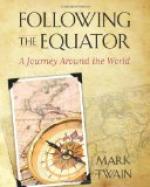Speaking of the indigenous coneys and bactrian camels, the naturalist said that the coniferous and bacteriological output of Australasia was remarkable for its many and curious departures from the accepted laws governing these species of tubercles, but that in his opinion Nature’s fondness for dabbling in the erratic was most notably exhibited in that curious combination of bird, fish, amphibian, burrower, crawler, quadruped, and Christian called the Ornithorhynchus—grotesquest of animals, king of the animalculae of the world for versatility of character and make-up. Said he:
“You can call it anything you want to, and be right. It is a fish, for it lives in the river half the time; it is a land animal, for it resides on the land half the time; it is an amphibian, since it likes both and does not know which it prefers; it is a hybernian, for when times are dull and nothing much going on it buries itself under the mud at the bottom of a puddle and hybernates there a couple of weeks at a time; it is a kind of duck, for it has a duck-bill and four webbed paddles; it is a fish and quadruped together, for in the water it swims with the paddles and on shore it paws itself across country with them; it is a kind of seal, for it has a seal’s fur; it is carnivorous, herbivorous, insectivorous, and vermifuginous, for it eats fish and grass and butterflies, and in the season digs worms out of the mud and devours them; it is clearly a bird, for it lays eggs, and hatches them; it is clearly a mammal, for it nurses its young; and it is manifestly a kind of Christian, for it keeps the Sabbath when there is anybody around, and when there isn’t, doesn’t. It has all the tastes there are except refined ones, it has all the habits there are except good ones.
“It is a survival—a survival of the fittest. Mr. Darwin invented the theory that goes by that name, but the Ornithorhynchus was the first to put it to actual experiment and prove that it could be done. Hence it should have as much of the credit as Mr. Darwin. It was never in the Ark; you will find no mention of it there; it nobly stayed out and worked the theory. Of all creatures in the world it was the only one properly equipped for the test. The Ark was thirteen months afloat, and all the globe submerged; no land visible above the flood, no vegetation, no food for a mammal to eat, nor water for a mammal to drink; for all mammal food was destroyed, and when the pure floods from heaven and the salt oceans of the earth mingled their waters and rose above the mountain tops, the result was a drink which no bird or beast of ordinary construction could use and live. But this combination was nuts for the Ornithorhynchus, if I may use a term like that without offense. Its river home had always been salted by the flood-tides of the sea. On the face of the Noachian deluge innumerable forest trees were floating. Upon these the Ornithorhynchus voyaged in peace; voyaged




